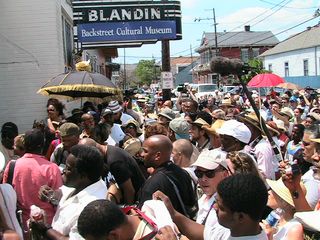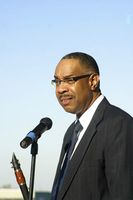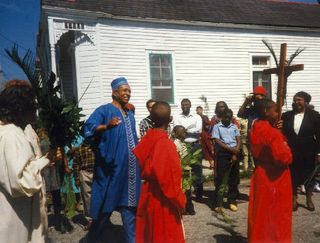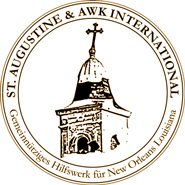St. Augustine Catholic Church * Tremé New Orleans
Sunday, August 28th - 2006
Father Jerome leDoux at 10am gives a Holy Memorial Mass for the St. Augustine parish of Tremé:
"A lot of folks will be crying.
The only thing of importance is that,
while we grieve our losses of loved ones,
we thank God and worship together in such a way
that we cement our solidarity in faith, in hope and in love."

From St. Augustine's on the way to Congo Square
We now may have a little glance at the history of the eldest Afro-American Catholic parish of the USA - the church being placed on the corner of Gov.Nicholls and St. Claude Street, in the parish of the Tremé - and we should recognize that most of the well known jazz musicians were bred in this parish - some even being baptized here - Sidney Bechet for example.
In the begining Tremé was a bigger area than today: Tremé also included Armstrong Park and the "project-houses" behind St. Louis Cemetery No.1.
In the late 1830s, when free people of color got permission from Bishop Antoine Blanc to build a church, the Ursulines donated the corner property at Bayou Road (now Governor Nicholls St.) and St. Claude which they had bought for $10,000, on the condition that the church be named after their foundress, St. Angela Merici. However, circumstances dictated that the church was named St. Augustine.
A few months before the October 9, 1842 dedication of St. Augustine Church, the people of color began to purchase pews for their families to sit. Upon hearing of this, white people in the area started a campaign to buy more pews than the colored folks. Thus, The War of the Pews began and was ultimately won by the free people of color who bought three pews to every one purchased by the whites. In an unprecedented social, political and religious move, the colored members also bought all the pews of both side aisles. They gave those pews to the slaves as their exclusive place of worship, a first in the history of slavery in the United States.
This mix of the pews resulted in the most integrated congregation in the entire country: one large row of free people of color, one large row of whites with a smattering of ethnics, and two outer aisles of slaves. Except for a brief six-month period when its sanctuary was enlarged and blessed in time for Christmas 1925, St. Augustine Church has been in continuous use as a place of worship until the present time.
1834 „Free people of colour“, start the St. Augustine parish - and from the beginnings of their church services in the Afro-American tradition music has played a very lively role.

Dr. Michael White
In most history books the beginning of jazz has been described as being closely linked with the functional music of the marching bands (Brass Bands) with marches, hymns, negro spirituals, blues and ragtime.
1918 the Italo-American „Original Dixieland Jazz Band“, a white band plays at Reisenweber's Cafe of New York. The musicians are Tony Spargo, Edwin "Daddy" Edwards, D. James "Nick" LaRocca, Larry Shields, Henry Ragas., and they have grown up in that part of New Orleans which now is called the 6th Ward – very close to the house of the great pianist and bandleader Jelly Roll Morton - and in between the many Social & Pleasure Clubs, that were the "home" of the Afro-American brass bands.
So they hear the gospels coming from the church, thus getting to know the classical hymns with the wonderful Afro-Caribbean rhythms. And they hear the brassbands who also combine their melodies with Afro-Caribbean rhythm patterns.
Thus we may understand that the musicians of the Original Dixieland Jazz Band were brought up within the Afro-Caribbean sound of the 6th ward; they picked up the tunes and finally recorded them for the first time. This makes us believe that Jazz possibly came from this region within a good functioning support system of church, social & pleasure club.
Thus the connection of church- and street music may be found in what we now call "second line beat", the most basic Afro-American beat of jazz in general. If you can't feel that beat you are no real jazz musician.
Social & Pleasure Clubs in the Afro-American tradition were actually still in existance until hurricane Katrina put most of them under water. And these clubs bore the spirits of the Afro-American culture: baptizing, marriage, birthdays and funerals. If you were a member of a social & pleasure club you had music for all the important occasions of a family. We will have to rebuild this most important system again.
St. Augustine Catholic Church TODAY
As this church has been connected to such local traditions since 1834 nearly everybody in the whole world knows that it must be kept alive - especially in the manner that Father Jerome leDoux has been practicing for many years.
As this church was built on the higher grounds of the area not really very much was damaged, and all the friends of Afro-American culture all over the world do believe that it is worthwhile having this one and only eldest Afro-American Catholic parish keep up the traditions.

This most important venture had been closed down by the church-administration of the arch-diocese - but the protest of the local parishioners and the protest of the external parishioners from all over the world made the archbishop open up the church again for 18 months (till Sep 2007)
And all of us, who are engaged in the relief organisation in New Orleans, Holland, Germany, France, Belgium .......... we do believe that our Pope John Paul was right when he said:
ALL CHURCHES SHOULD BE LIKE ST. AUGUSTINE (Sep 1987)
see: http://www.savestaugparish.org/
Facit: St. Augustine Catholic Church has been allowed to re-open as parish-centre till September 2007. If about 500 parishioners have registered by then, we have a big chance of keeping the Afro-American tradition alive at St. Augustine's.

We need more parishioners
Here's one of the reasons why St. Augustine & AWK International - the benevolent relief organization for New Orleans has been established. The more members who declare that they want to be external parishioners of St. Augustine's Church in the Tremé, the more membership fees we can pay to the parish via church-council.
Please feel encouraged to join our relief organization especially for this issue. We do trust in this parish. It will also contribute to the rebuilding of the social & pleasure clubs and it will play a major role in setting up a support system for post-trauma-stress counseling like it has been started in spring 2006 by the European doctors Lumma, Cardynaals and Schellings from Germany and Holland.
The Hurricane Brassband of Maastricht at St. Augustine's Tremé
Father Jerome G. LeDoux
"As we all know from painful histories around the world, great tragedies bring out the worst in many people, and, fortunately, also the best in most people.
In every ward and neighborhood, we find heartwarming stories of undying faith, trust, hope and daring, people sharing everything and risking their lives for a relative, friend or stranger.
Amid the dreaded hurricane aftermath of polluted waters and deserted neighborhoods, local police, state troopers, the National Guard and formidable troops like the 82nd Airborne of North Carolina patrolled the area and provided security.
Yet, we found our greatest security in each other, catching one another’s back in all situations.
While rebuilding has been the main focus of Katrina/Rita survivors in New Orleans and all up and down the Gulf Coast, our focus is the resurrection and rebuilding of the spirit of a people. Yes, God willing, we are going to be better than we have ever been."
You can find even much more about the meaning and history of the St. Augustine Church & Parish on these two websites:
http://www.savestaugparish.org/